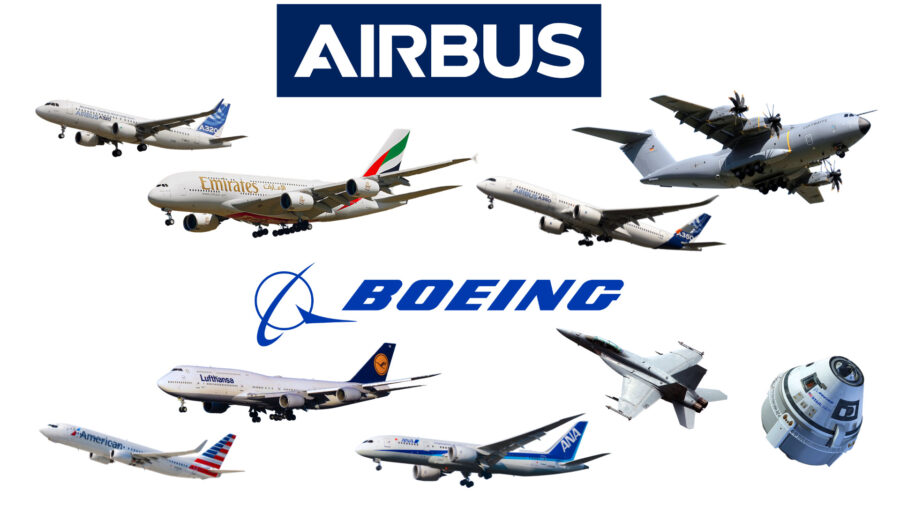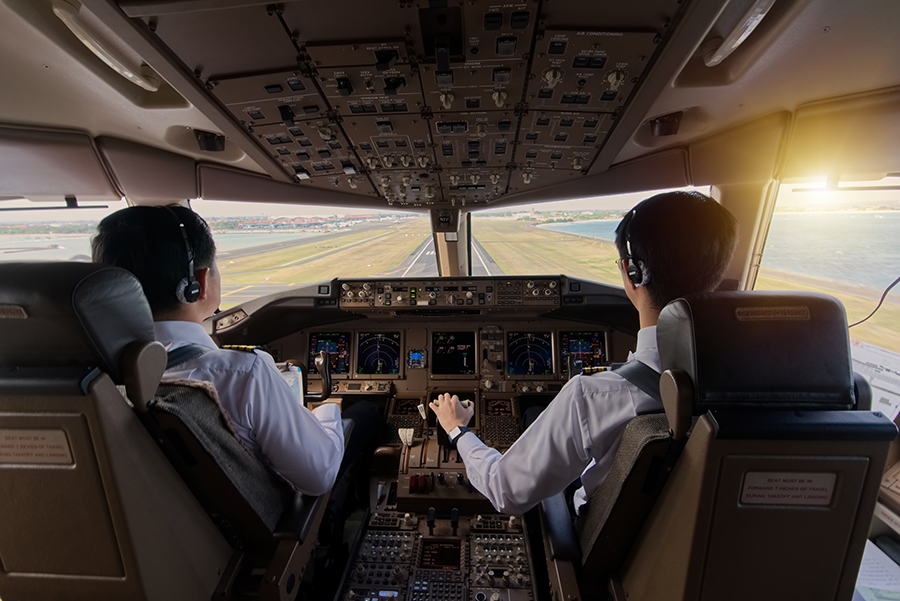-
Boeing vs. Airbus: The Fundamental Differences
- Control Systems
- Fly-By-Wire
- Autotrim
- Cockpit Design
- Cross-Model Similarity
- Market Segments
-
Airbus vs. Boeing Company Comparison
- Company History
- Product Lineup
- Market Share
- Manufacturing
- Environmental Efforts
- Challenges and Future
-
Airbus vs. Boeing Aircraft Comparison
- Narrow-Body Aircraft
- Wide-Body Aircraft
- Jumbo Jets
- Cockpit Systems
- Cabin Experience
- Technological Innovations
-
The History of the Rivalry between Airbus and Boeing
-
The Future of Airbus and Boeing
- Sustainable Aviation
- Digitalization
- Pilot Training
- Urban Air Mobility
- Supersonic Travel
- Market Adaptation
-
The Future of Airbus and Boeing
The fierce rivalry between Airbus and Boeing has raged for decades.
The Seattle-based Boeing has a rich history of producing world-class and iconic aircraft like the 747.
Airbus, headquartered in Blagnac, France, pushed the aviation industry into the modern age with systems such as fly-by-wire and quickly became a serious competitor in the global aviation market.
But what’s the difference between their aircraft? What led to the competition we see today?
And, more importantly, who will take control of the future skies?
The answer may surprise you.
Boeing vs. Airbus: The Fundamental Differences
There are a few fundamental differences that set Airbus and Boeing apart.
Let’s explore a few before diving into why the differences exist in the first place.
Control Systems
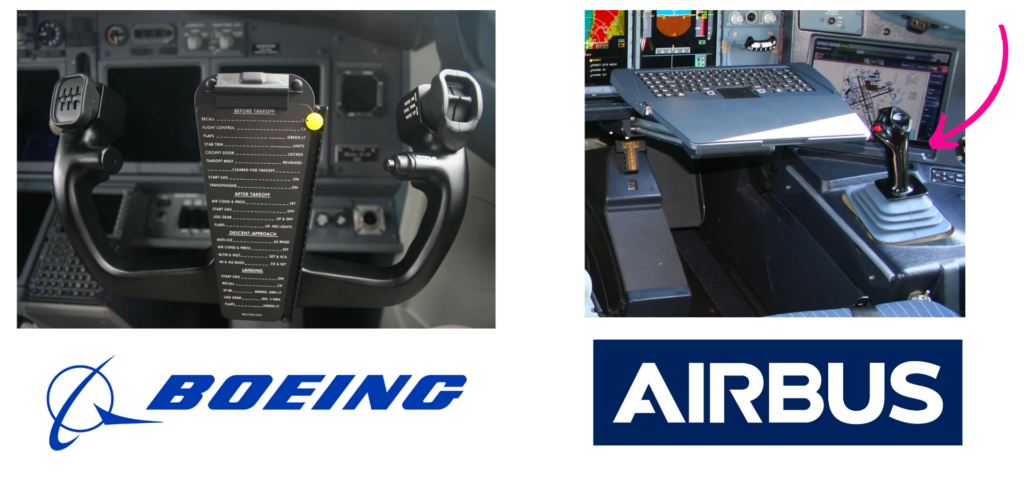
Boeing aircraft primarily use conventional control yokes, similar to steering wheels. These yokes provide pilots with a more familiar and hands-on control experience.
Airbus aircraft, in contrast, feature sidesticks. Sidesticks are more compact and ergonomic but offer less physical and visual feedback than yokes.
Fly-By-Wire
Airbus pioneered the fly-by-wire (FBW) system, replacing manual flight controls with electronic interfaces.
In an FBW system, when the pilot moves the controls, their input is converted into electrical signals. These signals are then sent to a computer, which processes the information and determines the best way to move the aircraft’s control surfaces, such as ailerons, elevators, and rudders.
Boeing also adopted fly-by-wire technology, but their system offers more tactile feedback, preserving some of the traditional “feel” of flying. This approach appeals to pilots who prefer a more hands-on experience.
Autotrim
Airbus aircraft are designed with an auto-trim system that automatically adjusts the plane’s trim during flight, helping maintain stability and reducing the pilot’s workload.
Boeing aircraft, however, requires pilots to make manual trim adjustments using a separate control. This design choice gives pilots more direct control over the aircraft’s behavior, which some pilots prefer.
Cockpit Design
Boeing cockpits feature a more traditional layout with numerous physical switches, dials, and gauges. This design can be more intuitive for pilots transitioning from older aircraft.
On the other hand, Airbus cockpits showcase a more modern, streamlined design, integrating digital displays and touchscreens. This approach reduces clutter and simplifies information management, making it easier for pilots to access critical data.
Cross-Model Similarity
Airbus emphasizes commonality across its aircraft models, meaning that pilots can more easily transition between different Airbus aircraft. This approach benefits airlines by reducing training time and costs.
Boeing’s aircraft, in contrast, have more variation in cockpit design and systems. While this can make transitioning between models more challenging, it allows Boeing to tailor each aircraft to specific market needs.
Market Segments
Boeing offers a diverse range of aircraft, catering to various market segments. Their lineup includes small regional jets like the 737 and large, long-range aircraft like the 777 and 787. This diversity allows Boeing to serve a wide array of customers and routes.
While offering fewer distinct models, Airbus also covers a broad range of sizes and capabilities, from the A320 for regional routes to the A380 for high-capacity, long-haul flights.
Airbus vs. Boeing Company Comparison
Company History
Boeing, an American aerospace company, was founded in 1916 by William E. Boeing. With over a century of experience, Boeing has played a significant role in shaping the aviation industry.
On the other hand, Airbus was established in 1970 as a European consortium, bringing together the aerospace capabilities of France, Germany, and the United Kingdom.
Over the past five decades, Airbus has grown rapidly, becoming a strong competitor to Boeing in the global market.
Product Lineup

Boeing offers a diverse lineup of aircraft, catering to various market segments. Their commercial aircraft include the 737 (narrow-body), 747 (jumbo jet), 767 (mid-size wide-body), 777 (large wide-body), and 787 (advanced wide-body). Boeing also produces military aircraft like the F/A-18 Hornet and space vehicles like the CST-100 Starliner.

Airbus primarily focuses on commercial aircraft, with popular models like the A220 (regional jet), A320 (narrow-body), A330 (wide-body), A350 (advanced wide-body), and A380 (jumbo jet). Airbus also has a military division, producing aircraft like the A400M transport plane.
Market Share
Boeing and Airbus have a fierce rivalry in the aviation market, constantly competing for new orders and customers.
In recent years, Airbus has held a slightly higher market share thanks to solid sales of its A320neo family.
Both companies continue to innovate and develop new aircraft models to outperform each other and capture a larger market share.
Manufacturing
Boeing’s primary manufacturing facilities are in the United States, with significant plants in Everett, Washington, and North Charleston, South Carolina.
Airbus, in contrast, has multiple production sites across Europe, including Toulouse, France; Hamburg, Germany; and Seville, Spain.
Both companies also rely on a global network of suppliers and partners, sourcing components and assemblies from numerous countries to support their manufacturing operations.
Environmental Efforts
Airbus and Boeing are committed to reducing their environmental impact by developing more fuel-efficient aircraft and adopting sustainable manufacturing practices.
Both companies have introduced new aircraft models, such as the Airbus A350 and Boeing 787, which use advanced materials and aerodynamic designs to minimize fuel consumption.
Additionally, both manufacturers are investing in research and development to explore alternative propulsion systems, including electric and hydrogen-based technologies, aiming to create a more sustainable future for aviation.
Challenges and Future
Airbus and Boeing face various challenges in the constantly evolving aerospace industry.
Economic fluctuations, geopolitical tensions, and changing regulations can all impact the companies’ performance and strategic planning.
Despite these obstacles, Boeing and Airbus continue to invest in new technologies and products to maintain their leadership in the aviation sector. They also adapt to market trends, such as the growing demand for more sustainable air travel and the need for more efficient aircraft to serve an increasingly interconnected world.
Airbus vs. Boeing Aircraft Comparison
Narrow-Body Aircraft
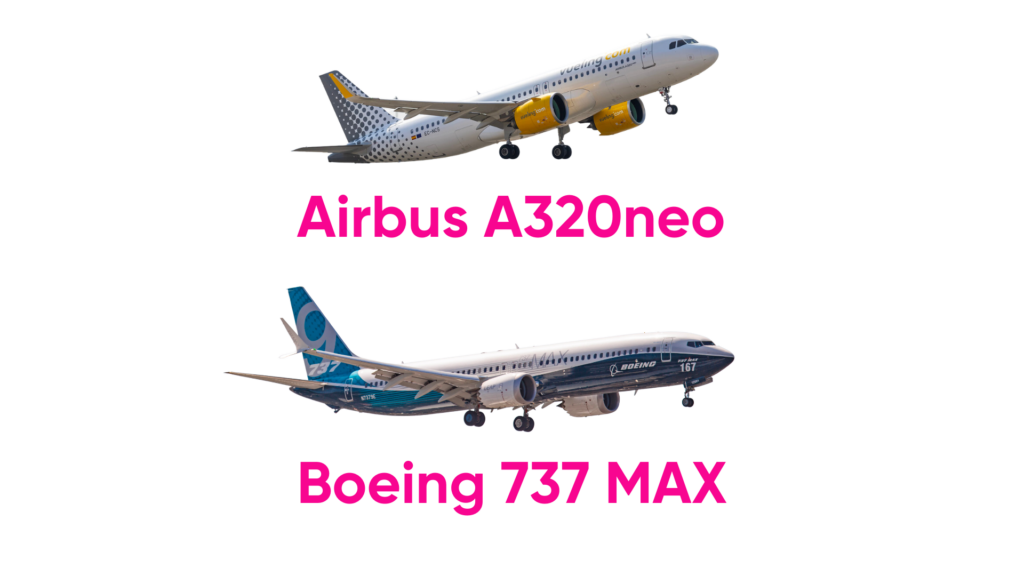
Boeing’s 737 MAX series and Airbus’ A320neo family are the leading narrow-body aircraft for short to medium-haul flights.
Both models feature advanced aerodynamics, updated cabin designs, and fuel-efficient engines. While the 737 MAX typically has a slightly longer range, allowing it to serve more distant routes, the A320neo family is known for its quiet operation and lower emissions.
Wide-Body Aircraft
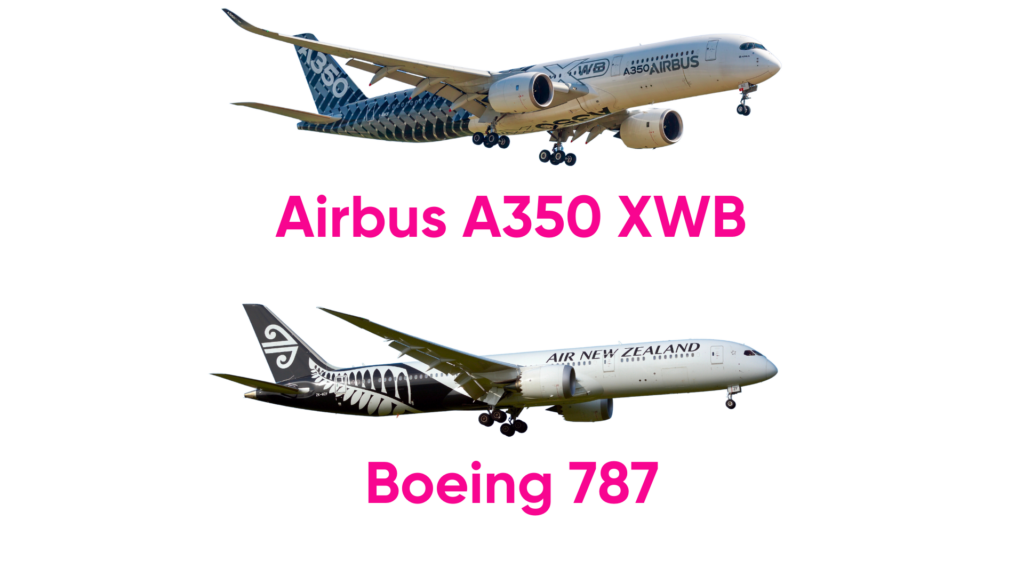
Boeing’s 787 Dreamliner and Airbus’ A350 XWB are state-of-the-art wide-body aircraft designed for long-haul flights.
Both aircraft use composite materials to reduce weight, improving fuel efficiency and reducing emissions. The A350 XWB can carry more passengers and offers a more spacious cabin, while the 787 Dreamliner is known for its large windows and innovative lighting system, which enhance passenger comfort on long flights.
Jumbo Jets
The Boeing 747-8 Intercontinental and Airbus A380 are renowned jumbo jets recognized for their size, range, and passenger capacity.
The 747-8 has a more fuel-efficient design, featuring advanced engines and aerodynamics, making it an attractive choice for long-haul operators.
The A380, on the other hand, boasts the highest passenger capacity of any commercial aircraft, accommodating up to 853 passengers in a typical two-class configuration.
As the aviation industry evolved, the demand for these jumbo jets significantly reduced. As such, the 747 and A380 are no longer in production.
Cockpit Systems
Boeing aircraft often incorporate more tactile feedback and manual controls in their cockpit systems, which appeal to pilots who prefer a traditional flying experience.
Airbus planes emphasize automation and computerized systems, reducing pilot workload but offering less hands-on control.
This difference in philosophy can impact a pilot’s preference for flying either Airbus or Boeing aircraft.
Cabin Experience
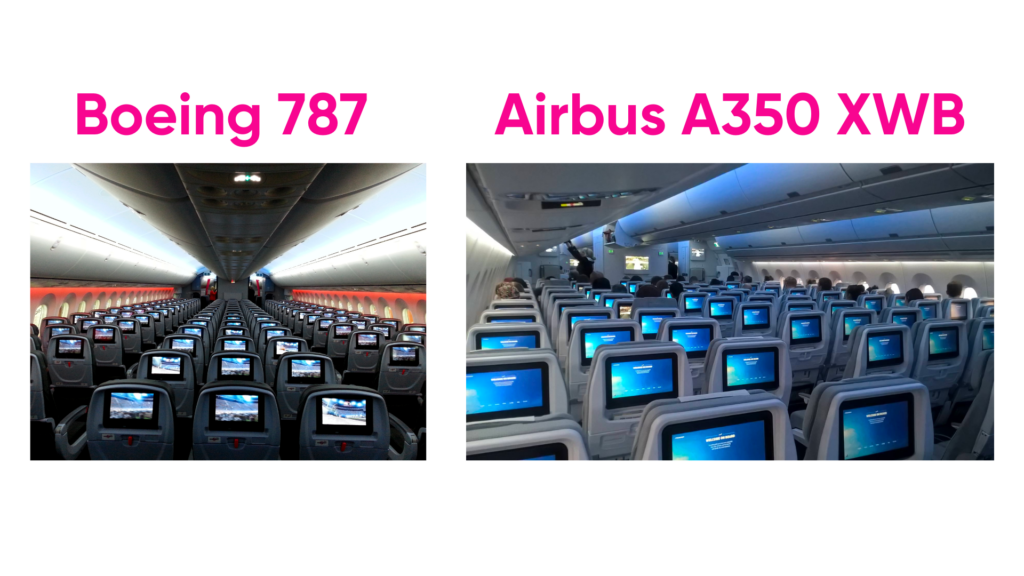
Airbus cabins typically have wider fuselage designs, providing passengers with slightly more space, comfort, and larger overhead bin storage.
Boeing cabins, while generally narrower, are known for their innovative lighting systems and large windows that enhance the passenger experience by creating a more spacious feel and offering better outside views.
Technological Innovations
Both Airbus and Boeing invest heavily in research and development to stay at the forefront of aviation technology.
Airbus is known for pioneering fly-by-wire systems, which replace conventional manual flight controls with electronic interfaces, improving flight safety and reducing pilot workload.
To minimize airline operating costs, Boeing focuses on advanced composite materials for lighter and stronger airframes and fuel efficiency innovations, such as winglets and advanced engine designs.
The History of the Rivalry between Airbus and Boeing
Boeing, founded in 1916, had already established itself as a dominant player in the aviation industry by the time Airbus was created in 1970. Airbus, a European consortium, was formed to challenge Boeing’s dominance and foster European cooperation in aerospace.
The competition between Boeing and Airbus began in earnest with the introduction of the Airbus A300, a wide-body aircraft designed to compete with Boeing’s 747. The A300’s advanced features and efficiency helped Airbus gain a foothold in the market.
Airbus introduced the A320 in 1987, a narrow-body aircraft with innovative fly-by-wire technology, directly challenging Boeing’s popular 737. This competition intensified over the years, with both companies continuously upgrading their offerings.
Boeing and Airbus have gone head-to-head in the wide-body market with aircraft like the Boeing 777 and Airbus A330, followed by the advanced Boeing 787 Dreamliner and Airbus A350 XWB. These models incorporate cutting-edge technology and materials to meet airlines’ evolving needs.
The iconic Boeing 747 jumbo jet faced competition when Airbus unveiled the A380, the world’s largest passenger aircraft, in 2005. While the A380 offered greater capacity, the 747-8 Intercontinental focused on fuel efficiency and operational flexibility.
Both Airbus and Boeing have faced their share of challenges, from technical issues to economic downturns and changing consumer preferences. The rivalry has pushed both companies to innovate and adapt to the ever-changing demands of the aviation industry.
The Future of Airbus and Boeing
Sustainable Aviation
Airbus and Boeing recognize the increasing importance of sustainability in aviation and are dedicating significant resources to develop more eco-friendly aircraft. This includes researching and implementing alternative fuels, such as biofuels and synthetic fuels, to reduce carbon emissions.
Additionally, both companies are exploring the potential of electric propulsion and hydrogen-based technologies as more sustainable power sources. These efforts aim to minimize aviation’s environmental impact and meet global emissions targets.
Digitalization
As digital technology advances, Airbus and Boeing are anticipated to integrate these innovations into their aircraft and operations. This may include enhancing aircraft connectivity to optimize flight planning, real-time data analytics to improve maintenance processes, and artificial intelligence systems to increase overall efficiency.
Integrating digital technology will likely transform how aircraft are designed, built, and operated, leading to safer and more efficient air travel.
Pilot Training
With the ongoing evolution of technology in aviation, pilot training must adapt to ensure that pilots are prepared to operate next-generation aircraft.
Airbus and Boeing are expected to invest in advanced training solutions like virtual reality simulators, integrated learning systems, and data-driven performance analysis. These innovative training methods can provide more realistic and immersive experiences, better-preparing pilots for the challenges they will face in the cockpit.
Additionally, unmanned aircraft systems are set to play a significant role in the skies of the future. Boeing and Airbus are aware of this, and the rise of automated flight will play a key role in who dominates the future skies.
Urban Air Mobility
The demand for urban air mobility solutions is growing, driven by increasing urbanization and the need for efficient, sustainable transportation options. Airbus and Boeing may respond to this emerging market by developing smaller, electric-powered aircraft, vertical takeoff and landing (VTOL) vehicles, or passenger drones.
These new aircraft designs could transform urban transportation, reducing congestion and providing more efficient alternatives to traditional ground-based options.
Supersonic Travel
With a renewed interest in supersonic travel, both Airbus and Boeing might explore the development of faster commercial aircraft capable of significantly reducing travel times. These supersonic aircraft would need to overcome environmental concerns, noise restrictions, and high development costs.
If successful, supersonic travel could revolutionize long-haul flights, creating new market opportunities and redefining the overall passenger experience.
For now, Airbus and Boeing are focusing their efforts elsewhere.
Market Adaptation
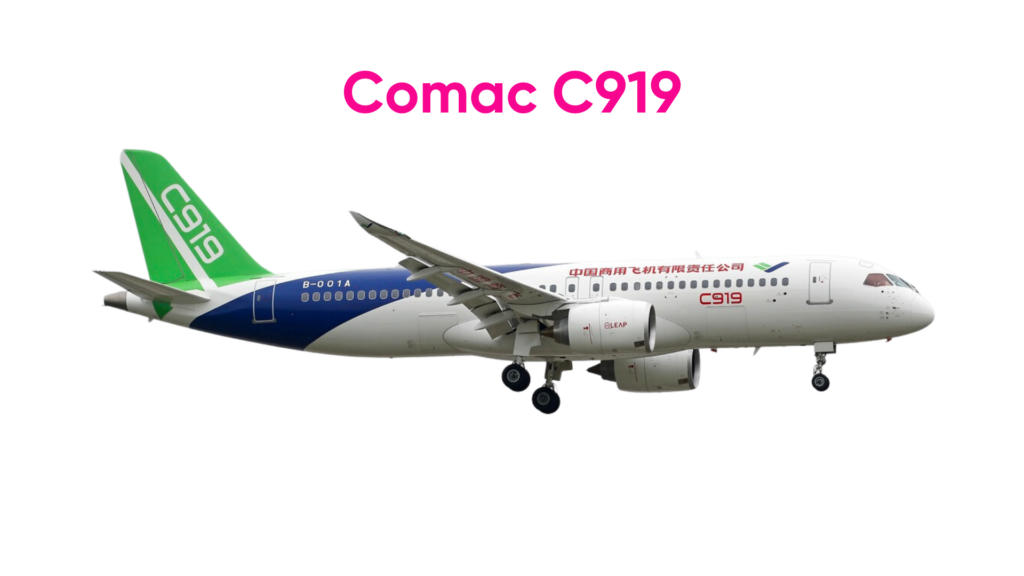
Airbus and Boeing must continuously adapt to the ever-changing aviation market to maintain their competitive edge. This involves addressing evolving customer preferences, such as the demand for more sustainable air travel options and personalized in-flight experiences. It also means navigating economic fluctuations, geopolitical dynamics, and regulatory changes that can impact the aviation industry.
The potential competition from other companies, such as Chinese-owned Comac, may intensify the battle between Boeing and Airbus or encourage cooperation – time will tell.
By remaining agile and responsive to market trends, both companies can continue to innovate and shape the future of aviation.
The Future of Airbus and Boeing
So, what does the future look like for Airbus and Boeing?
These two powerhouses have pushed each other to be the best in the aviation world for decades. They’re always on the cutting edge of technology, design, and efficiency, ensuring they stay at the top of the aircraft manufacturing game.
The key differences between their aircraft play a big part in why pilots and airlines might lean towards one over the other. But no matter the differences, both companies keep adapting and evolving to meet the ever-changing needs of the global aviation scene.
Looking forward, Airbus and Boeing will focus on sustainability, digitalization, pilot training, urban air mobility (think flying taxis), and adapting to the ever-changing aviation market.
We have yet to determine if they’ll team up, face new competition, or keep up their rivalry, but one thing’s for sure: the battle for the skies is far from over!
